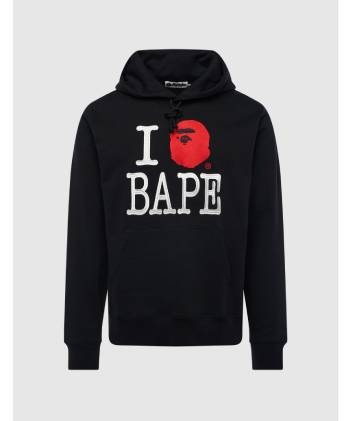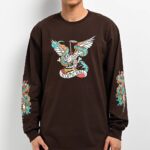Introduction to Bape Clothing
Bape, short for A Bathing Ape, isn’t just a clothing brand—it’s a lifestyle, a statement, and an entire subculture of its own. Founded in the heart of Tokyo’s Ura-Harajuku fashion scene, Bape redefined what it means to stand out in a world obsessed with uniformity. From its eccentric designs to its limited-edition releases, Bape Clothing became the ultimate representation of individuality in street fashion. When you first see a Bape hoodie or sneaker, it’s impossible not to recognize it. The bold colors, camo patterns, and unique shark motif scream confidence and attitude. It’s this distinctiveness that sets Bape apart from other streetwear brands. Bape doesn’t follow trends—it creates them. Today, Bape stands tall as one of the pioneers of global streetwear, alongside giants like Supreme, Off-White, and Palace. But Bape’s story isn’t just about fame or luxury—it’s about creativity, authenticity, and the art of self-expression through fashion.
What Is Bape?
At its core, Bape (A Bathing Ape) is a Japanese streetwear brand known for its bold prints, limited releases, and innovative collaborations. Established in 1993 by Tomoaki Nagao, better known as Nigo, Bape took heavy inspiration from pop culture, hip-hop, and the urban street scenes of Tokyo and New York. The brand name, A Bathing Ape in Lukewarm Water, symbolizes Japan’s overindulgent youth—people living comfortably in luxury. It’s a tongue-in-cheek reference to the modern consumer lifestyle, wrapped in vibrant, expressive streetwear. Bape’s early collections were produced in extremely limited quantities, making them instant collector’s items. This scarcity created hype before “hype culture” even existed. People didn’t just buy Bape—they hunted for it. And once you owned it, you weren’t just wearing clothes; you were wearing status.
The Origins of the Brand
Bape was born in Tokyo’s Harajuku district—a hub of creativity and rebellion. During the early 1990s, Nigo worked as an editor and stylist for Popeye magazine, a Japanese fashion publication. His experiences there introduced him to Western streetwear and hip-hop culture, which heavily influenced his vision for Bape. He opened the first Bape store, “Nowhere,” in 1993, partnering with Jun Takahashi, founder of Undercover. The shop quickly became the go-to spot for fashion-forward youth seeking something bold and unconventional. What truly made Bape stand out was its marketing genius. Nigo only produced about 30 to 50 shirts a week, selling them exclusively through his store or gifting them to celebrities. This limited availability made the brand mysterious, desirable, and unattainable—just the way Nigo intended.
The Philosophy Behind Bape’s Unique Style
Bape’s philosophy can be summed up in one word: individuality. Nigo designed each piece to help people express themselves without fear. Whether it’s the iconic camo hoodie or the colorful Bapesta sneaker, every design challenges traditional fashion norms. Unlike minimalist brands that value subtlety, Bape celebrates loudness. Every hoodie, T-shirt, and sneaker feels like a piece of wearable art. The brand combines elements of Japanese street style with American hip-hop influences, creating a fusion that resonates globally. The philosophy also extends to exclusivity. Bape never aims for mass production—it focuses on rarity and craftsmanship. When you wear Bape, you’re not just wearing clothing; you’re wearing a story, a culture, and an artistic legacy.
The Founder – Nigo’s Creative Vision
At the heart of Bape’s success lies the creative genius of Tomoaki Nagao, famously known as Nigo. He’s not just a fashion designer—he’s a visionary who redefined how people perceive streetwear. Before Bape, fashion was divided: luxury brands sat at the top while street fashion lived in underground subcultures. Nigo destroyed that wall completely. Bape Hoodie He took the raw energy of street life, mixed it with luxury aesthetics, and created something that appealed to both worlds. Born in 1970 in Maebashi, Japan, Nigo studied fashion editing at Bunka Fashion College, where he met several future icons of Japanese fashion, including Jun Takahashi (Undercover) and Hiroshi Fujiwara (fragment design). Influenced by American hip-hop, sneakers, and vintage pop culture, Nigo envisioned a brand that captured the rebellious yet refined spirit of youth culture.
He started small, producing limited runs of graphic tees, hoodies, and accessories. But what made Nigo different was his approach to branding. He didn’t rely on advertising or fashion shows. Instead, he built a cult following by keeping Bape intentionally exclusive and aligning it with hip-hop icons. Over the years, his collaborations with artists like Pharrell Williams, Kanye West, and Lil Wayne transformed Bape from a Japanese street label into a global fashion powerhouse. Even after selling the company in 2011, Nigo’s design DNA remains embedded in every Bape piece today—a mix of playful creativity, pop-culture nostalgia, and street authenticity.
How Nigo Built a Streetwear Empire
Bape’s rise wasn’t an accident—it was a masterclass in branding, scarcity, and timing. Nigo understood the psychology of desire long before social media made “hype” a marketing tool. He created demand by limiting supply. Only a few dozen items were produced each week, ensuring that owning Bape felt like a privilege. Nigo also understood the power of cultural influence. Instead of chasing traditional endorsements, he gave his clothes to rappers, DJs, and artists who embodied the brand’s coolness. When Pharrell, Kanye West, or Biggie Smalls wore Bape, the world noticed.
His stores became experiences, not just retail spaces. Each Bape store had unique architecture, futuristic displays, and exclusive items that couldn’t be found anywhere else. This made visiting a Bape store feel like entering a temple of fashion—a place where style met exclusivity. The result? A brand that didn’t just sell clothing but sold identity. Bape turned streetwear into a global fashion movement, inspiring countless other brands that followed.
Bape’s Early Influence on Global Fashion Culture
In the early 2000s, the global fashion scene started shifting. Luxury brands were beginning to notice the power of streetwear, and Bape was leading the charge. Its success showed that sneakers and hoodies could be just as valuable and respected as designer suits. Bape’s bold colors, oversized fits, and iconic prints stood out in an era dominated by minimalism. The brand’s crossover appeal—bridging Japanese craftsmanship with American hip-hop swagger—gave it an edge that few could replicate.
When international artists started wearing Bape in their music videos, the brand exploded globally. From Pharrell’s “Frontin’” video to Soulja Boy’s “Crank That”, Bape became a visual symbol of success, youth, and self-expression. Even major fashion houses began to take notes, eventually collaborating with streetwear designers to capture the same energy that Bape pioneered.
Collaborations That Changed the Game
If there’s one thing Bape is famous for besides its bold designs, it’s its legendary collaborations. Nigo was one of the first designers to see the power of partnerships. Instead of keeping Bape isolated, he merged it with other creative worlds—from music and art to sports and gaming. Some of Bape’s most famous collaborations include partnerships with Adidas, Pepsi, Star Wars, Marvel, and Nintendo. Each collaboration was more than just a branding stunt—it was an event. Fans lined up for hours (or days) just to grab a limited-edition piece that combined two cultural icons.
Perhaps one of the most influential collaborations was Bape x Kanye West, which produced the Bapesta “College Dropout” sneakers. These sneakers have since become one of the most sought-after collector’s items in sneaker history. Through these collaborations, Bape transcended fashion and became part of global pop culture. It proved that streetwear wasn’t just a niche—it was the future of style.
The Signature Bape Aesthetic
When you think of Bape, one word immediately comes to mind: bold. The brand’s aesthetic is instantly recognizable and impossible to ignore. From its playful patterns to its high-energy color palettes, Bape’s designs redefine what streetwear can be. At the center of this aesthetic is Bape’s unique camo pattern, a reinvention of military camouflage that uses vibrant shades of blue, green, pink, and purple. Unlike traditional camo meant for blending in, Bape’s version is designed to stand out. This “Ape Camo” has become synonymous with the brand, appearing on hoodies, sneakers, accessories, and even furniture. Then there’s the iconic Shark Hoodie—arguably Bape’s most recognizable piece. The zip-up hood that reveals a shark face when closed became an instant status symbol among streetwear enthusiasts. It’s playful, aggressive, and perfectly in line with Bape’s rebellious spirit.
Another core visual is the Ape Head Logo, inspired by the 1968 film Planet of the Apes. This logo is more than just branding—it’s a badge of identity for those who embrace originality and creativity. Whether printed on a tee or embossed on sneakers, it represents the spirit of the streetwear movement that Bape helped define. Bape’s design philosophy doesn’t aim for subtlety. It celebrates excess, youth, and artistic freedom. Every pattern, stitch, and color tells a story of a brand that refuses to be ordinary.
Iconic Bape Camo Patterns
Bape’s camo isn’t just a print—it’s a cultural statement. Introduced in the late 1990s, Bape Camo revolutionized how fashion viewed military-inspired design. Traditional camouflage was meant to conceal, but Bape’s version was meant to shine. The brand experimented with different colors and themes—like 1st Camo, Snow Camo, and ABC Camo—each with its own signature look. The vibrant patterns instantly became collectible, appearing on everything from sneakers and backpacks to chairs, strollers, and even cars.
What made Bape Camo so special was its versatility. It worked across various fashion categories—men’s, women’s, and children’s wear. No matter where it appeared, it always commanded attention. Beyond aesthetics, the camo pattern embodies Bape’s philosophy of standing out in a world that tries to make you fit in. It’s a visual representation of confidence, originality, and rebellion. Shop Now



